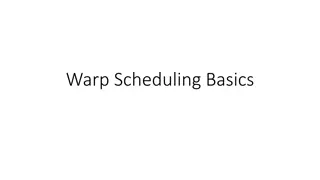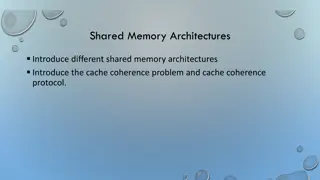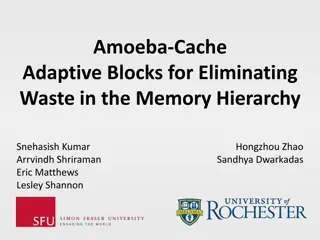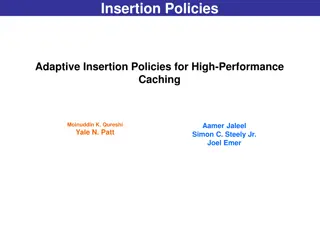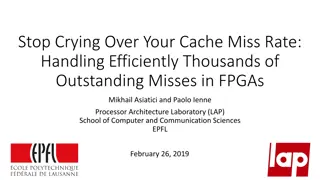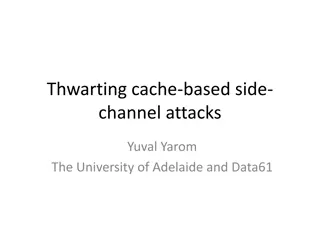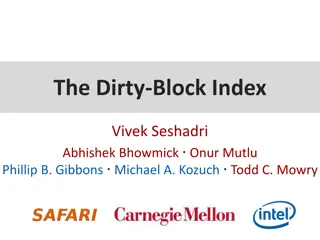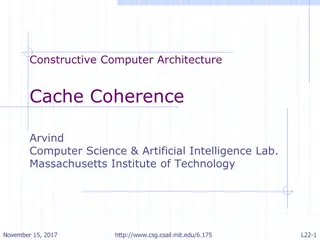Data Access Predictions in Cache Systems
Predicting the future in cache systems involves prefetching to optimize data accesses. Explore spatially and temporally predictable patterns, irregular access challenges, cache line size impact, and next-line prefetching strategies.
Download Presentation

Please find below an Image/Link to download the presentation.
The content on the website is provided AS IS for your information and personal use only. It may not be sold, licensed, or shared on other websites without obtaining consent from the author.If you encounter any issues during the download, it is possible that the publisher has removed the file from their server.
You are allowed to download the files provided on this website for personal or commercial use, subject to the condition that they are used lawfully. All files are the property of their respective owners.
The content on the website is provided AS IS for your information and personal use only. It may not be sold, licensed, or shared on other websites without obtaining consent from the author.
E N D
Presentation Transcript
CS7810 Prefetching Seth Pugsley
Predicting the Future Where have we seen prediction before? Does it always work? Prefetching is prediction Predict which cache line will be used next, and place it in the cache before it is used A processor cache is required
Data Accesses What is it about data accesses in programs that makes them predictable? Spatially predictable Temporally predictable Virtual page boundaries Regular vs Irregular
Regular Data Access = Regular Data Access Some patterns are very easy to accurately predict.
Irregular Data Access = Irregular Data Access Pointer-chasing patterns are impossible to predict without large, comprehensive histories.
Mixed Data Access = Irregular Data Access = Regular Data Access Some applications have a combination of both types. For example, a linked list where each item is several cache lines long.
Cache Line Size Overfetching and Prefetching Main memory access granularity vs program access granularity Large cache lines have more spatial locality Why not just use huge cache lines? Where is the limit?
Next Line Prefetching For every cache line A that is fetched, also prefetch A+1 There is no intelligence or decision making, it always performs the same action How is this different from having twice the cache line size? Alignment Eviction granularity
Prefetch Aggressiveneess Cache Capacity Prefetched lines take up cache capacity Memory Bandwidth Prefetched lines use memory bandwidth Accuracy vs Cache Miss Coverage Fundamentally at odds with one another Timeliness Does the prefetched line arrive on time? How does a Next Line Prefetcher fare in these metrics in the best case? Worst case?
Stream Prefetcher Prefetch multiple +1 lines ahead Requires confirmation before any action is taken Stream started on access A Stream direction determined on access A+1 Stream confirmed on access A+2 Begin prefetching A+3 Intelligence and bookkeeping required to identify and confirm these streams Prefetch degree is how many cache lines are prefetched at a time
Stream Prefetcher = Demand Miss = Prefetch Stream Prefetchers are good at prefetching very long regular streams.
Stream Prefetcher First Access Second Access Direction Next Expected Next Prefetch Accesses: 0, 1, 2, 10, 11, 3, 12, 4, 5 Prefetched:
Stride Prefetcher Like a stream prefetcher, but with variable access stride (not always +1) More bookkeeping to determine stride Also requires confirmation before prefetching Allocate stream on access A Determine direction and stride on access A+X Confirm stream on access A+2*X Begin prefetching A+3*X
Stride Prefetcher First Access Second Access Stride Next Expected Next Prefetch Accesses: 0, 4, 8, 53, 56, 101, 12, 16, 20, 59, 62, 65 Prefetched:
Common Regular Data Prefetchers If you understand these, then you re off to a good start Next Line Stream Stride Now we will introduce more advanced topics
Correlation Prefetchers Correlate events in a history Assume history repeats itself History Table Indexed by some key, e.g., PC or load address Table entry tells prefetching algorithm what to do Can correlate a variety of things Total access order (on a pair by pair basis) Distances between accesses
Correlation Prefetchers Index Next 0 1 Accesses: 0, 7, 3, 6, 2, 1, 5, 4, 7, 3, 0, 7, 2, 1, 5, 0, 4, 7, 2, 1, 5, 0, 7, 3, 6 2 3 4 5 6 7
Global History Buffer Nesbit and Smith, 2005 Instead of just one history table, uses an index table and global history buffer Index table is accessed by directly indexing into it GHB is a FIFO with pointers between entries This can be used as a framework to implement other prefetchers Still very popular basis for new prefetchers
Global History Buffer Index Ptr History 0 1 Accesses: 0, 2, 3, 1, 2, 0, 2, 3, 0, 2, 3, 1, 2, 0, 2, 3, 0, 2 2 3
Access Map Pattern Matching JILP Data Prefetching Championship 2009 Exhaustive search on a history, looking for regular patterns History stored as bit vector per physical page Shift history to center on current access Check for patterns for all +/- X strides Prefetch matches with smallest prefetch distance
Summary Some data accesses are predictable Regular vs Irregular data access patterns Three must-know prefetchers Next Line, Stream, Stride Fourth must-know prefetcher Global History Buffer





